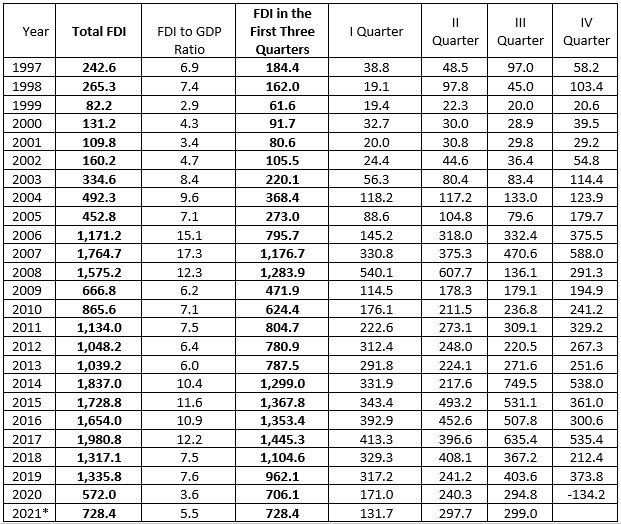Saba Buadze: “Investment inflows to Georgia are at a historic low.”
Verdict: FactCheck concludes that Saba Buadze’s statement is MOSTLY TRUE.
Resume:
According to the information of the National Statistics Office of Georgia, foreign direct investments (FDI) to Georgia reached GEL 572 million in 2020 which is the lowest figure since 2005. In 2020, the foreign direct investments to the GDP ratio was 3.6% which is also the lowest figure since 2001. According to the data of the first three quarters of 2021, FDI amounted to USD 728.4 million which is USD 22 million more as compared to the same period of 2020. According to the data of the first three months of 2021, less investments were made only in 2010 (in the pre-pandemic period). The FDI to the GDP ratio in the first three quarters of 2021 is 5.5% which is the lowest figure since 2002 whilst not taking 2020 into account. To be fair, it needs to be underlined that the pandemic conjuncture had a catastrophic impact on the investment field not only for Georgia but across the globe. At first glance, the Government of Georgia can only partially be responsible for the situation in 2020-2021 whilst Saba Buadze’s statement was intended to criticise the government. However, the investment dynamic in Georgia was problematic well before the pandemic period. In addition, Mr Buadze highlights the halting of large infrastructural projects, such as the Anaklia sea-port, in his statement, which is a legitimate concern.
Reinvestment largely accounted for the existing volumes of investment in 2020-2021. The reinvestment figure was also high in 2019 and amounted to nearly 48% of the total investments. The higher share of investment within the FDI structure indicates that little new investments are being made which is a negative occurrence for a country like Georgia and underpins Mr Buadze’s emphasis. Given the full context, Saba Buadze’s statement is mostly true, since the statement is accurate albeit in need of additional information and clarification in terms of the dynamics of absolute figures and the pandemic context.
Analysis
Lelo for Georgia member, Saba Buadze, stated: “Investment inflow to Georgia is at a historic low.” Of note is that Mr Buadze made this statement within the context of the halting of large infrastructural projects such as Anaklia sea-port.
According to the current data, the National Statistics Office of Georgia has published the FDI statistics for the first three quarters of 2021. According to these data, FDI amounted to USD 728.4 million which is USD 22 million more as compared to the same period of 2020. According to the data of the first three months of 2021, less investments were made only in 2010 (in the pre-pandemic period). In 2020, FDI to Georgia was USD 572 million which is the lowest figure since 2005. In the fourth quarter of 2020, the FDI balance was negative, meaning that investment outflows exceeded investment inflows. In terms of quarterly dynamics, this was the first time since 1995 (according to available statistics) when the FDI figure was negative. The detailed statistics of foreign direct investments in 1997-2021 (first three quarters) are given in Table 1. Together with the absolute figures, it is also important to take a look at the FDI to the GDP ratio since a specific absolute figure can be very large vis-à-vis a smaller economy and very small vis-à-vis a larger economy. However, it needs to be added that FDI to GDP ratio calculations before 2010 and after 2010 can be made for guidance purposes alone because the National Statistics Office of Georgia recalculated the GDP after 2010 with a new methodology which resulted in the growth of the GDP figures for that period. According to the data of the first three quarters of 2021, the GDP to the FDI ratio was 5.5% which is the lowest figure since 2002, excluding 2020. In 2020, the FDI to the GDP ratio was 3.6% which is the lowest figure since 2001.
Table 1: Foreign Direct Investments in 1997-2021(First three quarters), USD Million

Source: National Statistics Office of Georgia
To be fair, it needs to be underlined that the pandemic in 2020-2021 had a devastating impact on the investment field not only for Georgia but across the globe. In this regard, the Government of Georgia can only partially be responsible for this situation. However, the investment dynamic in Georgia was problematic well before the pandemic period
Foreign direct investments consist of three major components: equity capital of investors, reinvestments and debt obligations. In the course of 2020, equity capital flows dropped to a minimum and amounted to USD 29 million (a mere 5% of the total investments) whilst reinvestment amounted to USD 500 million (87.5% of the FDI) which was mostly attributable to the pandemic-induced crisis. In the statistics of the first three quarters of 2021, reinvestment volumes increased further and reached USD 613 million which accounted for 84.2% of the total investments whilst the equity capital volume in the same period amounted to USD 84 million (11.5% of the FDI). The reinvestment figure was also high in 2019 and amounted to 47.5% of the total investments. The higher share of investment within the FDI structure indicates that little new investments are being made which is a negative occurrence for a country like Georgia and underpins Saba Buadze’s emphasis.
Table 2: Structure of the FDI in 2013-2021, USD Million

Source: National Statistics Office of Georgia









